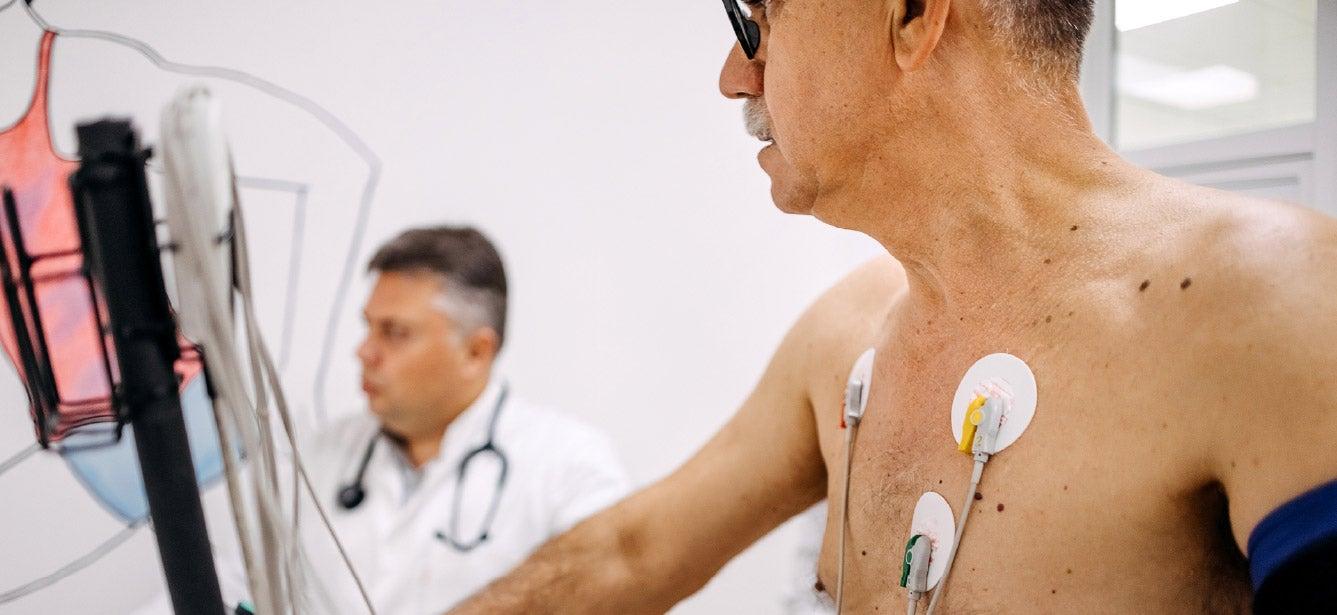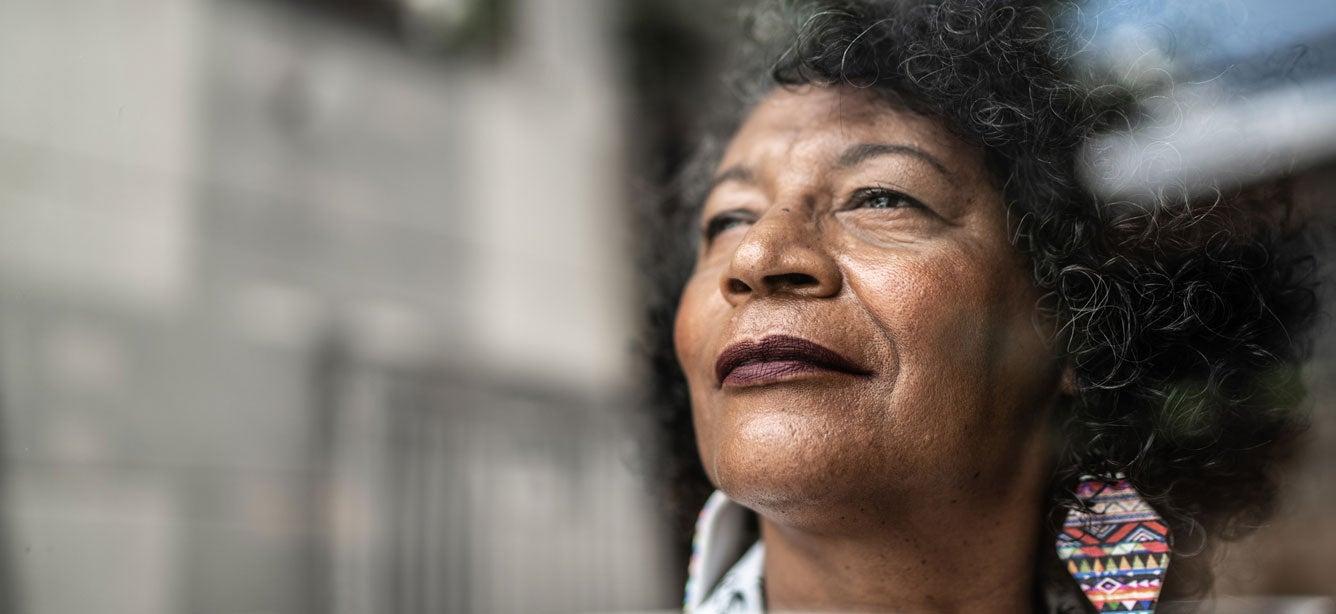
Related Topics
Osteoporosis is not a normal part of aging. Nor does it commonly affect men. It’s little wonder, then, that Baltimore resident Ed Doyle made it to age 73 without giving much thought to his bone health.
“My family tends to live to almost 100,” Ed, now 77, explained. “I like to say that we enjoy good deteriorating health!”
Neither Ed’s mother nor his grandmothers showed any signs or symptoms of osteoporosis that he was aware of, and none of his relatives has ever broken a bone. Still, something prompted Ed’s doctor at Johns Hopkins Medicine to order a bone density test—also known as a DXA scan, when he was 73 years old.
The results surprised them both: Ed had osteoporosis. His doctor immediately recommended medication to slow down bone loss.
Osteoporosis: A hidden danger
“Had it not been for that DXA scan, Ed may never have discovered the truth: that his bones had become weak and that he was at an elevated risk for falling and potentially experiencing a life-changing broken bone,” said Dorothea Vafiadis, Senior Director of NCOA’s Center for Healthy Aging.
That’s because osteoporosis has a reputation as a “silent disease,” and for good reason: most people who live with it never know until they break a bone.
About 54 million people in the U.S. have osteoporosis.1 While the vast majority of them are women who have reached menopause, men do still develop the condition; of those 54 million, 2 million are male. As many as 12 million more men are vulnerable.1
“That literally means that millions of older adults could benefit from screening,” Vafiadis said. “And that’s true regardless of biological sex.”
As Ed’s doctor knew, a DXA scan is the gold standard for identifying (or ruling out) osteoporosis and its precursor, osteopenia (low bone mineral density).
What is a DXA (or DEXA) scan?
Short for dual energy X-ray absorptiometry, this specialized imaging test measures the mineral content in a person’s bones—usually in the hips, spine, and wrists.2 Often called a “bone density test,” the results help determine whether someone is experiencing bone loss as they age and at what rate.
Patients lie comfortably on a table for the test. A non-invasive scanner takes continuous X-rays using low levels of radiation to gather bone density data that a specialized physician can then interpret.
DXA scans are precise, painless, simple, and affordable, which makes them an attractive and viable screening tool. The U.S. Preventive Services Task Force currently recommends bone density testing for3:
- All women age 65 and older
- Postmenopausal women under age 65 at higher risk for osteoporosis
The task force stops short of recommending screening for men due to “insufficient evidence,” but that evidence is changing, and guidelines are under review.
Why did Ed get a DXA scan?
Because he lacked symptoms, Ed isn’t sure. But one of two factors, or both together, could explain his doctor’s decision:
1. Ed’s lifestyle
While generally a healthy person, Ed has a congenital heart condition that kept him from ever playing sports as a kid. On top of that, his severe dyslexia meant he felt more comfortable in quiet, less social situations throughout his formative years. He was a technology enthusiast, spending a great deal of time in sedentary activities.
“I just processed information so differently,” Ed explained. “Technology became my outlet.”
Ed was the first of anyone he knew to have purchased a computer when the machines hit the open market—and, as he remembers, was among the original cohort of “regular people” to have accessed the early internet through an employer-sponsored pilot program. That experience opened up a whole new way of interacting and understanding the world, and he was hooked.
“All these things planted me in a chair,” Ed explained, “and I’ve been there ever since.”
Today, the medical community better understands the direct relationship between physical activity and bone health. And all of Ed’s sitting likely worked against his.
“Sedentary people, whether by choice or not, are at greater risk for developing osteoporosis than those who aren’t,” Vafiadis said. “That’s because exercise, especially the weight-bearing kind, is essential for building and maintaining strong bones.”
In fact, according to the American Academy of Orthopedic Surgeons, weight bearing exercise is “essential” during the teenage years in order to achieve maximum bone health.4 After age 25, the bone-building benefits of exercise include preserving existing bone mass, strengthening muscles, and preventing falls that can lead to potentially life-changing breaks.
In both regards, Ed was out of luck.
2. Ed’s age
Ed’s doctor also could have been following advice from the Bone Health and Osteoporosis Foundation, which recommends DXA scans for men over age 70 who have average risk for the condition.5
Why? For one thing, one in four older adults in the U.S. experiences a fall every year. And when older adults with osteoporosis fall, they are more likely to break a bone.
Falls are not a normal part of aging. But the “side effects” of growing older—poorer eyesight, hearing loss, certain medications—contribute to higher risk. Identifying osteoporosis doesn’t prevent falls, but preventing falls is crucial to avoiding broken bones that can lead to lost independence.
It worked for Ed. Once he learned of his diagnosis, he took control of his risk. He recently signed up for a bone health lecture at Arbutus Senior Center in Baltimore and reported that what he learned made a difference.
Something else helped Ed, too. Immediately following his diagnosis, his doctor prescribed an osteoporosis drug to increase his bone density. Ed has taken it religiously ever since, and reported that his most recent bone density test, in October 2021, showed “significant improvements.” By working as intended to increase Ed’s bone density, the drug also increased Ed’s bone strength. That’s because the two are directly proportional. Now, Ed is much better protected against potential fractures.
Happily married for 53 years with a son and grandson, Ed today lives a rich life informed—but not defined by—his osteoporosis. “I live carefully, but not fearfully,” he concluded. Especially around his rescue cat Rumi.
FAQ
What are the risk factors for osteoporosis?
In addition to family history and a sedentary lifestyle, risk factors can include:
- Calcium and Vitamin D deficiencies
- Low body weight and a small frame
- Certain chronic conditions, such as diabetes
- Certain medications, such as steroids
- Smoking
- Consuming more than two alcoholic drinks per day for men or more than one per day for women
What are common signs or symptoms of osteoporosis?
Sometimes, as Ed knows, there are none. When there are, the most common include:
- Back pain
- Losing an inch or more in height
- Hunched posture
Additionally, any bone fracture in men or women after age 50 could indicated the presence of osteoporosis and should be evaluated.
Should I get a DXA scan?
Only your doctor can answer that for sure, says Vafiadis. “But if you meet any of the symptoms or risk factors mentioned above, it’s definitely worth asking the question.”
Ed’s story, and our content covering bone health for older adults, was developed in partnership with Amgen. Learn more about Amgen’s commitment to supporting the osteoporosis community through innovative research, treatments, and education.
Sources
1. Cleveland Clinic. Osteoporosis. Found on the internet at https://my.clevelandclinic.org/health/diseases/4443-osteoporosis
2. Cleveland Clinic. DEXA (DXA) Scan: Bone Density Test. Found on the internet at https://my.clevelandclinic.org/health/diagnostics/10683-dexa-dxa-scan-bone-density-test
3. U.S. Preventive Services Task Force. Final Recommendation Statement. Osteoporosis to Prevent Fractures: Screening. June 26, 2018. Found on the internet at https://www.uspreventiveservicestaskforce.org/uspstf/recommendation/osteoporosis-screening
4. OrthoInfo. Exercise and Bone Health. Found on the internet at https://orthoinfo.aaos.org/en/staying-healthy/exercise-and-bone-health/
5. Bone Health & Osteoporosis Foundation. Evaluation of Bone Health/Bone Density Testing. Found on the internet at https://www.bonehealthandosteoporosis.org/patients/diagnosis-information/bone-density-examtesting/



